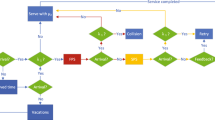Abstract
This paper considers the delay distributions in a two-class non-preemptive priority queue with crossover feedback. Specifically, there are two priority classes, and the Poisson arrival process for each class can be subdivided into two groups: one group which only requires service at the priority level to which it arrives, and another group which requires subsequent service after it feeds back to the other queue. Our main result is the determination of explicit expressions for the distribution of delay until final service commences for each the four types of customers.
Similar content being viewed by others
References
P. Brill, An embedded level crossing technique for dams and queues, J. Appl. Probab. 16 (1979) 174–186.
R.M. Conway, W. Maxwell and L. Miller, Theory of Scheduling (Addison-Wesley, Reading, MA, 1967).
J. Daigle, Task-oriented queueing: An analysis tool for software design of communication processing systems, IEEE Trans. Commun. 34 (1986) 250–256.
J.N. Daigle and C. Houstis, Analysis of a task oriented multi-priority queueing system, IEEE Trans. Commun. 29 (1981) 1669–1677.
B. Fontana, Queue with two priorities and feedback: Joint queue-length distribution and response time distributions for specific sequences, in: ITC, Vol. 10, Montreal, 1983.
B. Fontana and C.D. Berzosa, Stationary queue-length distributions in an M/G/1 queue with two non-preemptive priorities and general feedback, in: IFIP, 1984, pp. 333–347.
E. Jewkes and J. Buzacott, Flow time distributions in a K class priority feedback queue, Queueing Systems 8 (1991) 183–202.
L. Kleinrock, Queueing Systems, Vol. 1 (Wiley, New York, 1975).
G.P. Klimov, Time-sharing service systems I, Theory Probab. Appl. 19 (1974) 532–551.
G.P. Klimov, Time-sharing service systems II, Theory Probab. Appl. 23 (1978) 314–321.
R. Serfozo, Introduction to Stochastic Networks (Springer, New York, 1999).
G. Shanthikumar, Some analysis on the control of queues using level crossings of regenerative processes, J. Appl. Probab. 17 (1980) 814–821.
B. Simon, Priority queues with feedback, J. Appl. Comput. Math. 31 (1984) 134–149.
D. Tcha and S.R. Pliska, Optimal control of single server queueing networks and multi-class M/G/1 queues with feedback, Oper. Res. 25 (1977) 248–258.
J. Walrand, An Introduction to Queueing Networks (Prentice-Hall, Englewood Cliffs, NJ, 1988).
R.W. Wolff, Poisson arrivals see time averages, Oper. Res. 30 (1982) 223–231.
Author information
Authors and Affiliations
Rights and permissions
About this article
Cite this article
Jewkes, E., Stanford, D. A Two Priority Queue with Crossover Feedback. Queueing Systems 43, 129–146 (2003). https://doi.org/10.1023/A:1021856632000
Issue Date:
DOI: https://doi.org/10.1023/A:1021856632000




